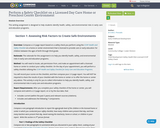
This writing assignment is designed to help students identify health, safety, and environmental risks in early care and education programs.
- Subject:
- Early Childhood Development
- Material Type:
- Module
- Author:
- Dr D.M.C. Preciado
- Date Added:
- 09/15/2019

This writing assignment is designed to help students identify health, safety, and environmental risks in early care and education programs.

This is a parenting tool to be sent for support with reducing impulsive speech at home.

Bildung hat das Ziel, kreatives und kritisches Denken zu entwickeln und erweitert unsere Teilhabemöglichkeiten. Bekommen Kinder die Chance, häufig und regelmäßig mit anderen Kindern und mit Erwachsenen über schwierige Fragen nachzudenken, hilft ihnen dies von Anfang an, selbstkritisch und kreativ zu denken. Sie lernen, Überzeugungen zu begründen, zu diskutieren und sich ein eigenes Urteil zu bilden. Die hier zur Verfügung gestellte Auflistung bietet in dem Zusammenhang einen Überblick über bestehende Materialien zur Thematik für die Anregung einer inklusiven Pädagogik in Kindertageseinrichtungen.
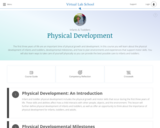
The preschool years are an important time of physical activity and development. In this course, you will learn about typical motor skill development and what to do if you are concerned about a child’s development. You will also learn how to plan indoor and outdoor experiences that promote physical development and support families and children as they pursue an active lifestyle.
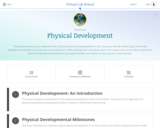
The preschool years are an important time of physical activity and development. In this course you will learn about typical motor skill development and what to do if you are concerned about a child’s development. You will also learn how to plan indoor and outdoor experiences that promote physical development and support families and children as they pursue an active lifestyle.
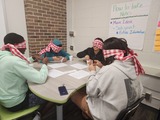
This is the first lesson in the PIESM Development Concepts, Physical Development. In this lesson, there is vocabulary, notes, and two activity stations that require observations. At the end, there is a reflective peice that requires use of student observation and analysis using developmental concepts learned.
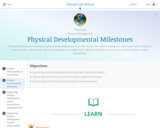
This lesson will help you understand typical physical development or, in other words, how children develop and refine motor skills, during their preschool years. You will learn about the progression of developmental milestones and what to do if you are concerned about a child’s development.

Created by Michael Krahn & Gabriel Robinson, "Physical Skills & Well-Being - Kindergarten" is used as a safe, healthy, & fun lesson plan for kindergarteners that teaches them the importance physiccal activity, healthy diets, keeeping up with responsibilities affects their well-beings, created in a way that is easy and accesible for children aged 4-6 in the kindergarten education level.
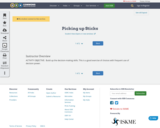
ACTIVITY OBJECTIVE: Build up the decision-making skills. This is a good exercise of choices with frequent use of decision power.

To teach children about consequences and the importance of being honest.

Ingenious Innovations by Black, Indigenous, and People of Color
Word Count: 9881
(Note: This resource's metadata has been created automatically by reformatting and/or combining the information that the author initially provided as part of a bulk import process.)
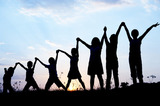
Slide Deck about the importance of play- 2019
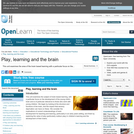
This unit examines the area of the brain based learning with a particular focus on the development of the young child's brain and is of particular relevance to those who work with young children. We begin by looking at the structure and functions of the brain, and the impact that sensory deprivation can have on these. We consider the implications of current understandings of brain development for teaching and learning, particularly in an early years setting, and finish by exploring the value of play (particularly outdoor play) in children's learning and the development of their brains.
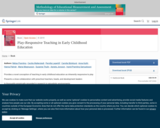
This open access book develops a theoretical concept of teaching that is relevant to early childhood education, and based on children’s learning and development through play. It discusses theoretical premises and research on playing and learning, and proposes the development of play-responsive didaktik. It examines the processes and products of learning and development, teaching and its phylogenetic and ontogenetic development, as well as the ‘what’ of learning and didaktik. Next, it explores the actions, objects and meaning of play and provides insight into the diversity of beliefs about the practices of play. The book presents ideas on how combined research and development projects can be carried out, providing incentive and a model for practice development and research. The second part of the book consists of empirical studies on teacher’s playing skills and examples of play with very young as well as older children.
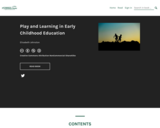
This resource is a pressbook that centers around early childhood education.

Play is something that every child enjoys doing. Since this is the case why not use play as a tool for education? Playing with the intent to learn is a great way to keep students interested and motivated in the lessons. This OER talks about different aspects of using play as a learning tool and why it is beneficial for all students.

A set of number playdough mats to help children develop their fine motor skills and identify the numbers from 0 to 20.

The Playful Learning Challenge's Pre-K and Kindergarten Math Activities Kit contains a series of 10 research-based early math activities centered around play, that can be used with simple materials in children's classrooms or homes.
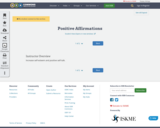
Increase self-esteem and positive self-talk.